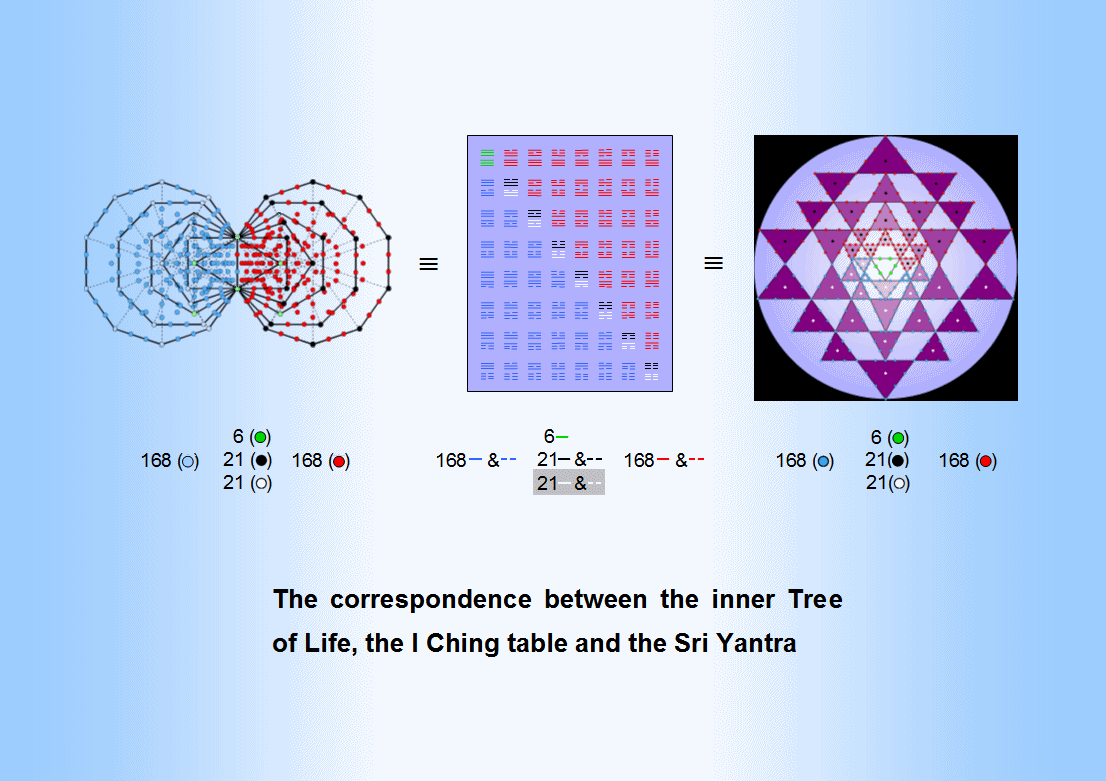
| << Previous 1... 37 38 [39] 40 41 ...45 Next >> |
Excluded from the 189 intervals are the octave note, the octave interval & the tonic. They are symbolized in the diagram below by the three green yods associated with the right-hand set of the first six polygons, namely, the topmost endpoint of the root edge, the corner of the triangle outside the root edge and the lowest corner of the hexagon. The three green yods that are their mirror images in the other set of polygons symbolize the next lower octave 1/2, the falling octave interval 1/2 and the unit interval 1. We conclude that, including these two triplets of intervals, which set the range of the rising and falling intervals in the octave, the intervals between the notes in the seven scales split up into 64 triplets of ascending intervals belonging to the set {m} of 192 tone ratios and 64 triplets of falling intervals that belong to the set {1/m} of their reciprocals. Their representations by three holistic systems are displayed below.

The two halves of each system represent the 192 rising intervals and the 192 falling intervals. The 63 trigrams in
each half other than the pair of green Heaven trigrams in the upper left-hand corner of the 8×8 array denote the 63
triplets, each triplet consisting of an interval up to 1024/729, its inversion and an unpaired interval. This means
that. although there are 21 notes with tone ratios up to 1024/729, they cannot be symbolized
by the 21 lines & broken lines in the seven diagonal trigrams. As the 63 trigrams contain
93 lines and 96 broken lines but there are 123 Pythagorean and 66 non-Pythagorean intervals, the two types of lines
cannot symbolize these two types of musical interval. Nor can it correspond to the distinction between intervals
and their inversions, for there are 125 intervals up to 1024/729 (see the table in #37) and 64 intervals larger than that. The
truth is more subtle.
The micro-biological counterpart of the 64 triplets of rising intervals and the 64 triplets of falling intervals that make up the seven musical scales are the 64 codons in mRNA and the 64 anticodons in tRNA. Their encoding in sacred geometries is discussed fully in Article 46 (WEB, PDF). The DNA molecule is itself a holistic object in the sense that its 64 possible codons conform to the universal 64-fold pattern found in both sacred geometries and the seven diatonic, musical scales. Nitrogen base complementarity (A↔T & C↔G) corresponds to the pairing of rising intervals with their falling counterparts and to the division of systems of sacred geometry into two halves that are mirror images of each other. In the case of the I Ching table of 64 hexagrams, the 64 trigrams in its upper diagonal half represent the 64 triplets of rising intervals (a note interval paired with its inversion & an unpaired interval), whilst the 64 trigrams in its lower half represent the 64 triplets of falling intervals. The Yang/Yin dichotomy of the lines and broken lines corresponds to nitrogen base complementarity and to the fact that every rising interval between two notes has its falling counterpart, whilst every one of the 192 yods intrinsic* to the first six enfolded polygons on the right of their shared root edge has its mirror image among the 192 yods intrinsic to the first six enfolded polygons on the left side.
* "Intrinsic" means that the yod belongs solely to the polygons enfolded in a particular Tree of Life. Notice that the topmost corners of the two hexagons do not have a coloured yod assigned to them. This is because these points are shared with the hexagons enfolded in the next higher Tree, coinciding with their lowest corners, and so are intrinsic to the inner form of this Tree. Sharing of these corners means that the set of the first (6+6) polygons enfolded in successive Trees contains (192+192=384) intrinsic yods that symbolise the 192 rising and 192 falling intervals between the notes in the seven octave species.
| << Previous 1... 37 38 [39] 40 41 ...45 Next >> |